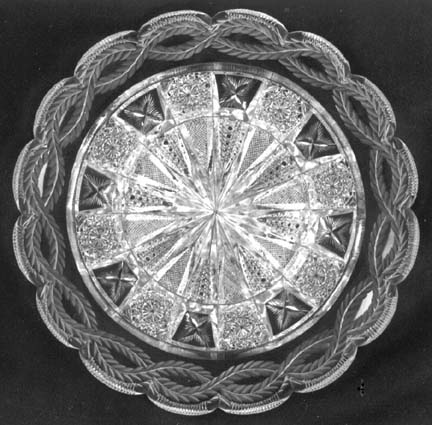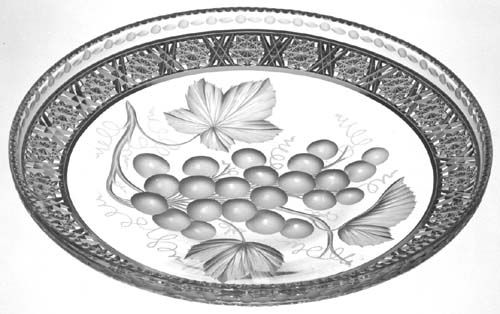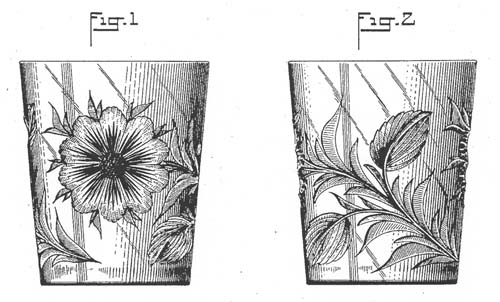Tuthill Cut Glass Company
American Brilliant Glass Education and Research - HBG
Plate Cut and Engraved in the “Orient” Pattern by the Tuthill Cut Glass Company
Tuthill’s excellent reputation is based, to a large extent, on a style that combines stone-wheel engraving with brilliant geometric cutting, produced with a high degree of precision on excellent blanks. The pattern on this plate is called “Orient” according to an ad that was placed by the Philadelphia jewelry firm of Bailey, Banks and Biddle in an as-yet unidentified publication about 1910. It is reproduced in The Hobstar, Vol. 5, No. 4, p. 5 (Jan 1983).
The ad shows cut and engraved glassware exclusively. In keeping with the conservative practices of established jewelers at this time it does not mention the Tuthill company by name, but all of the cut-glass patterns shown can be found on signed Tuthill glass. “Orient” could be the factory name, but it is equally likely to be one assigned by the retailer. Until its status is confirmed, the name should be enclosed within quotation marks.
Plate cut and engraved in the “Orient” pattern by the Tuthill Cut Glass Company (signed). Early twentieth century. D = 7″ (17.8 cm), wt = 1.5 Lb (0.7 kg). This plate is considered a rarity; it sold for $650 in 1982.

Historical Sketch, Trademarks, and Catalog
The company that Charles Guernsey Tuthill opened in Middletown, NY in 1899, Charles G. Tuthill & Company, had existed from 1895 as an independent cutting shop in Corning, NY, where Tuthill received training in glass cutting and engraving. The Middletown company was re-organized in 1902 as the Tuthill Cut Glass Company with Susan and Fred Tuthill as partners. In Middletown the company produced typical brilliant-period cut glass, especially during its earliest years. The unpublished Salesmen’s Photo Inventory, below, provides an introduction to these early patterns. Well before 1910, however, patterns commonly included stone-wheel engravings of fruits and flowers, often combined with geometric cuttings. The company’s most famous all-geometric design is the “Rex” pattern which helped the company win a gold medal at the Panama – Pacific International Exposition in 1915, although the pattern probably was designed several years earlier. (While there is little doubt that this pattern-name is official, it has yet to be found in any catalog or other official company publication; therefore, quotation marks are called for.)
Trademarks
Tuthill glass is usually “signed” with an acid-etched script signature, but probably only from about 1910. The trademark itself can vary, as shown by the following three examples:



Catalog
 [c1900 Salesmen’s Photo Inventory] This is a collection of photographs: geometric patterns, all numbered (two with names added: Bar Harbor and Columbian). Some, perhaps all, of the items were cut at Tuthill’s shop in Corning (1895-1899) and continued to be produced in Middletown, NY for a few years after Tuthill moved there in 1899. The photo inventory contains the paper label shown on the left. It was probably used only to identify glass sent to dealers and removed before resale. The number 53 identifies the pattern used. The photo inventory has been duplicated on a CD-R that can be obtained from the ACGA, P. O. Box 482, Ramona, CA.
[c1900 Salesmen’s Photo Inventory] This is a collection of photographs: geometric patterns, all numbered (two with names added: Bar Harbor and Columbian). Some, perhaps all, of the items were cut at Tuthill’s shop in Corning (1895-1899) and continued to be produced in Middletown, NY for a few years after Tuthill moved there in 1899. The photo inventory contains the paper label shown on the left. It was probably used only to identify glass sent to dealers and removed before resale. The number 53 identifies the pattern used. The photo inventory has been duplicated on a CD-R that can be obtained from the ACGA, P. O. Box 482, Ramona, CA.
Principal sources:
Crofford, Maurice, 2000: Tuthill cuts for gold, Glass Collector’s Digest, Jun/Jul, pp. 19-27, and
Crofford, Maurice, 2001: THE RICH CUT GLASS OF CHARLES GUERNSEY TUTHILL. Texas Univ. Press, College Station, TX, 211 pp.
The foregoing publications are unreliable blendings of fact and fiction that contain numerous errors. (See the crofford1.htm file in Part 1.)
Emmerson, Leigh, 2005: ACGA Tuthill document, The Hobstar, Vol. 28, No. 2, pp. 4586-8 (Oct 2005).
Pearson, J. M. and D. T. Pearson, 1965: AMERICAN CUT GLASS FOR THE DISCRIMINATING COLLECTOR, pp. 149-156.
Pearson, J. M. and D. T. Pearson, 1969: A STUDY OF AMERICAN CUT GLASS COLLECTIONS, pp. 129-131.
Sinclaire, E. F. and J. S. Spillman, 1997: THE COMPLETE CUT & ENGRAVED GLASS OF CORNING, pp. 167-168 and pp. 287-289.
Waldron, A. J., 2000: New sources revise Tuthill history. Part 1, The Hobstar, Vol. 23, No. 2, pp. 10-15 (Oct); Part 2, The Hobstar, Vol. 23, No. 3, pp. 14-18 (Nov).
See Smith 2005b (pp. 531-46) for correspondence between Louise Boggess and Wallace Turner concerning the pattern names that have been assigned to Tuthill cut glass.
Vintage Pattern with Geometrics by the Tuthill Cut Glass Company
Tray cut and engraved in the “Vintage (Intaglio Grapes) with Geometric and Engraved Border” pattern by the Tuthill Cut Glass Company (signed). D = 9.88″ (25.1 cm), H = 1.5″ (3.8 cm), wt = 2.25 lb (1.0 kg). Sold for $675 in 1988.

Patented Pattern (1912)
Only one patented pattern is associated with the Tuthill Cut Glass Company. The asterisk (*) indicates that the patent was retained by the patentee; it was not assigned to the company.
Patent no. / Catalog or “Coined” Name / Patentee / Application Filed / Date Granted
42,367 / “Floral” / Thomas Mortenson / 12 Jan 1912 / 26 Mar 1912 (*)

Content courtesy of Warren and Teddie Biden and Jim Havens